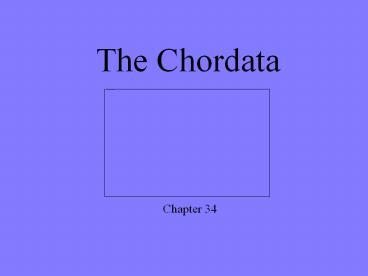The Chordata - PowerPoint PPT Presentation
Title:
The Chordata
Description:
The Chordata Chapter 34 – PowerPoint PPT presentation
Number of Views:127
Avg rating:3.0/5.0
Title: The Chordata
1
The Chordata
Chapter 34
2
Weve done some of this before
3
Fig. 34-2
Echinodermata (sister group to chordates)
Cephalochordata (lancelets)
ANCESTRAL DEUTERO- STOME
Chordates
Urochordata (tunicates)
Notochord
Myxini (hagfishes)
Common ancestor of chordates
Craniates
Petromyzontida (lampreys)
Head
Vertebrates
Chondrichthyes (sharks, rays, chimaeras)
Vertebral column
Actinopterygii (ray-finned fishes)
Gnathostomes
Jaws, mineralized skeleton
Actinistia (coelacanths)
Osteichthyans
Lungs or lung derivatives
Lobe-fins
Dipnoi (lungfishes)
Lobed fins
Amphibia (frogs, salamanders)
Tetrapods
Reptilia (turtles, snakes, crocodiles, birds)
Legs
Amniotes
Amniotic egg
Mammalia (mammals)
Milk
4
(No Transcript)
5
Fig. 34-2
Echinodermata (sister group to chordates)
Cephalochordata (lancelets)
ANCESTRAL DEUTERO- STOME
Chordates
Urochordata (tunicates)
Notochord
Myxini (hagfishes)
Common ancestor of chordates
Craniates
Petromyzontida (lampreys)
Head
Vertebrates
Chondrichthyes (sharks, rays, chimaeras)
Vertebral column
Actinopterygii (ray-finned fishes)
Gnathostomes
Jaws, mineralized skeleton
Actinistia (coelacanths)
Osteichthyans
Lungs or lung derivatives
Lobe-fins
Dipnoi (lungfishes)
Lobed fins
Amphibia (frogs, salamanders)
Tetrapods
Reptilia (turtles, snakes, crocodiles, birds)
Legs
Amniotes
Amniotic egg
Mammalia (mammals)
Milk
6
Figure 34.2 Chordate characteristics
7
Figure 34.4b Subphylum Cephalochordata the
lancelet Branchiostoma
8
Figure 34.4a Subphylum Cephalochordata lancelet
anatomy
The lancelet, Subphylum Cephalochordata, has all
four chordate synapomorphies
9
Figure 34.9 A hagfish
, Class Myxini
A skull of cartilage, but no jaw and no vertebrae
10
Figure 34.7 Phylogeny of the major groups of
extant vertebrates
11
Figure 34.9 A sea lamprey
Lampreys, Class Pteromyzontida The first
vertebrates lack jaws
12
Figure 34.11 Cartilaginous fishes (class
Chondrichthyes) Great white shark (top left),
silky shark (top right), southern stingray
(bottom left), blue spotted stingray (bottom
right)
Cartilaginous fishes, (class Chondricthyes)
jaws, paired appendages, mineralized skeletons
13
Note The BCOR 12 tutoring room (Sunday night
from 730-9pm) has been changed to L/L A101 (not
A161). Darlene will NOT be available this
Sunday. HW is due this Sunday night at 1159
p.m., as usual.
14
Why are humans considered members of the
chordates when we have no notochord, pharyngeal
slits, or muscular tail?
Clicker Question
- Our mammalian ancestors show some of these
traits. - Other similar traits appear in humans.
- Our nerve cord has replaced the notochord.
- Embryonic humans have these traits.
- More than one of the above.
15
Fig. 34-2
Echinodermata (sister group to chordates)
Cephalochordata (lancelets)
ANCESTRAL DEUTERO- STOME
Chordates
Urochordata (tunicates)
Notochord
Myxini (hagfishes)
Common ancestor of chordates
Craniates
Petromyzontida (lampreys)
Head
Vertebrates
Chondrichthyes (sharks, rays, chimaeras)
Vertebral column
Actinopterygii (ray-finned fishes)
Gnathostomes
Jaws, mineralized skeleton
Actinistia (coelacanths)
Osteichthyans
Lungs or lung derivatives
Lobe-fins
Dipnoi (lungfishes)
Lobed fins
Amphibia (frogs, salamanders)
Tetrapods
Reptilia (turtles, snakes, crocodiles, birds)
Legs
Amniotes
Amniotic egg
Mammalia (mammals)
Milk
16
Figure 34.12a Ray-finned fishes (class
Actinopterygii) yellow perch
Ray-finned fishes (class Actinopterygii)
lungs or lung derivatives
Clade Ostichtyes, the bony fishes
17
Figure 34.13 Anatomy of a trout, a
representative ray-finned fish
18
Fig. 34-2
Echinodermata (sister group to chordates)
Cephalochordata (lancelets)
ANCESTRAL DEUTERO- STOME
Chordates
Urochordata (tunicates)
Notochord
Myxini (hagfishes)
Common ancestor of chordates
Craniates
Petromyzontida (lampreys)
Head
Vertebrates
Chondrichthyes (sharks, rays, chimaeras)
a q u a t i c
o s t i c h t h s
Vertebral column
Actinopterygii (ray-finned fishes)
Gnathostomes
Jaws, mineralized skeleton
Actinistia (coelacanths)
Osteichthyans
Lungs or lung derivatives
Lobe-fins
Dipnoi (lungfishes)
Lobed fins
Amphibia (frogs, salamanders)
Tetrapods
Reptilia (turtles, snakes, crocodiles, birds)
Legs
Amniotes
Amniotic egg
Mammalia (mammals)
Milk
19
Figure 34.18 A coelocanth (Latimeria), the only
extant lobe-finned genus
The coelocanth (class Actinistia) first appeared
in the fossil record in the Devonian
20
Figure 34.16 Skeleton of Acanthostega, a
Devonian tetrapod fish
Transitional tetrapods -- feet in place but gills
and tail with fin
21
Figure 34.17 Amphibian orders Newt (left), frog
(right)
Class
Amphibia
Clade Tetrapods Synapomorphy four walking legs
22
Figure 34.18 Dual life of a frog (Rana
temporaria)
23
Note The Tri-Beta honors society will be having
its regular intro bio tutoring sessions Monday
and Tuesday after break, 6 - 8pm in Rowell 244.
This is in addition to the regular Sunday
sessions in Living and Learning.
24
Figure 34.22 A hatching reptile
Class Reptilia
Clade Amniotes Synapomorphy the amniotic egg
25
Figure 34.24 Amniotic egg
Amnion cushioning chamber for embryo Chorion
gas exchange to exterior Allantois disposal
sac Yolk sac surrounds yolk
26
Figure 34.23 A hypothetical phylogeny of amniotes
27
Figure 34.24 Extant reptiles Desert tortoise
(top left), lizard (top right), king snake
(bottom left), alligators (bottom right)
28
Figure 34.23 A hypothetical phylogeny of amniotes
29
Archaeopteryx (150 mybp) feathered wings and
powered flight, but retained ancestral
characteristics such as teeth, clawed wings, and
a long tail.
30
Figure 34.29 A small sample of birds
Blue-footed boobies (top left), male peacock (top
right), penguins (bottom left), perching bird
(bottom right)
Modern birds endotherms with feathers of
keratin, circa 10,000 species
31
Figure 34.23 A hypothetical phylogeny of amniotes
32
Synapsid reptiles evolved into large carnivores
and herbivores during the Permian period.
Diversity was much reduced in the Permian
-Triassic extinction.
33
Class Mammalia amniotes that have hair and
produce milk
34
Figure 34.36 Hypothetical cladogram of mammals
35
Fig. 34-33a
(a) A young brushtail possum
36
Eutherians, the placental mammals internal
gestation
37
Figure 34.35 A phylogenetic tree of primates
38
Figure 34.34 ProsimiansLemurs
39
Figure 34.39 Upright posture predates an
enlarged brain in human evolution
40
Fig. 34-2
Echinodermata (sister group to chordates)
Cephalochordata (lancelets)
ANCESTRAL DEUTERO- STOME
Chordates
Urochordata (tunicates)
Notochord
Myxini (hagfishes)
Common ancestor of chordates
Craniates
Petromyzontida (lampreys)
Head
Vertebrates
Chondrichthyes (sharks, rays, chimaeras)
Vertebral column
Actinopterygii (ray-finned fishes)
Gnathostomes
Jaws, mineralized skeleton
Actinistia (coelacanths)
Osteichthyans
Lungs or lung derivatives
Lobe-fins
Dipnoi (lungfishes)
Lobed fins
Amphibia (frogs, salamanders)
Tetrapods
Reptilia (turtles, snakes, crocodiles, birds)
Legs
Amniotes
Amniotic egg
Mammalia (mammals)
Milk






























